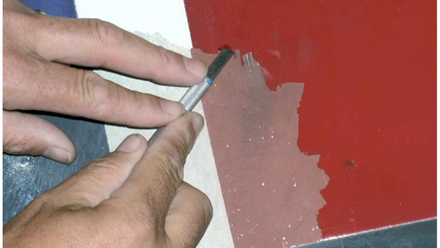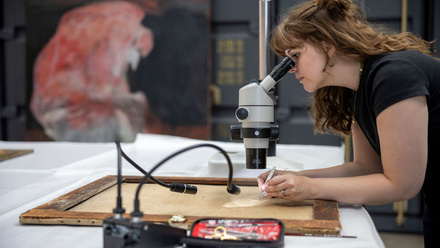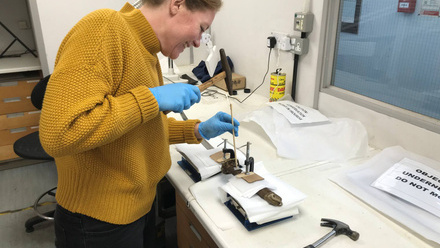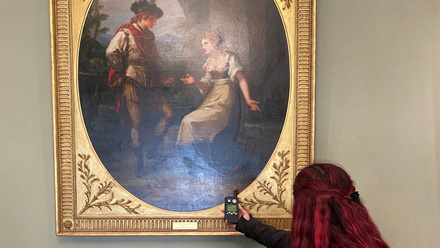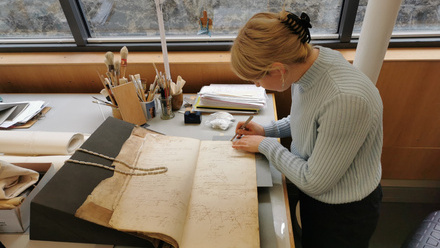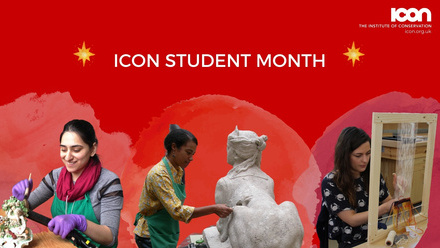I would first like to thank the Clare Hampson Fund for their generosity in supporting this Icon Internship and for giving me the fantastic opportunity to specialise in Photograph Conservation.
My overall impressions
For the last 12 months I have been on an Icon Internship in Photograph Conservation and Audience Engagement. The internship was generously sponsored by the Clare Hampson Fund, and I worked at The National Archives and Tate, under supervisor Jacqueline Moon ACR, now Conservation Manager for Paper and Photographs at Tate.
As well as learning how to identify and conserve black and white, and colour photographs, this internship showed me that there are many other skills required for a successful conservation career within a cultural institution. Team working and communication are important to be able to convey ideas and conservation issues to work well within your department, collaborate across a large organisation and speak to public audiences. Good organisation and time management is key, as I learnt while working on the film survey at The National Archives, in order to deliver a successful project within the deadline. Proficient IT skills are also a great advantage, to be able to use the various museum management systems and other IT programmes effectively in everyday work; and of course, a conservator should think critically, be meticulous and have a high attention to detail.
Building knowledge: identification and treatment of black and white photographs at The National Archives
I decided to apply for the Icon Internship so that I could bring together my MA in the Conservation of Works of Art on Paper and my BA in Fine Art Photography. I had previous knowledge of how photographs are made but had limited knowledge of how they are conserved. I was excited to find out what this new specialism would entail.
I spent my first few weeks learning how to identify historical black and white prints; distinguishing between the distinctive yellowing of albumen prints, the mirrored surface of silver gelatin prints, and the rich, matt surface of platinum prints. As I soon understood, the multitude of experimental processes, coatings and toning techniques used in the wake of photography’s invention can make the process of identification tricky, even for the well-trained eye. Nevertheless, as the weeks and months went on, I began to gain confidence in my ability to differentiate between these nuances.
I studied common causes of deterioration; the fading, mirroring and yellowing of these images which for me had always brought a sense of nostalgia and fascination, are in fact signs of poor processing, the influence of uncontrolled environmental conditions or proximity to non-archival materials and housings.
As my knowledge grew, I began to test out some basic conservation techniques such as surface cleaning and repair. I then worked on two collections from The National Archives; photographs of historic ships and atmospheric images of dockyards, some were panoramas and folded into bound volumes. There were very sooty, and some were torn and creased. I cleaned and stabilised them so that they could be safely accessed by staff and readers. To my surprise, many of the techniques I had learned in the treatment of paper objects were transferable to photographs, however, the multi-layered and complex material chemistry of each process must be thoroughly understood to carry out safe and effective treatments.
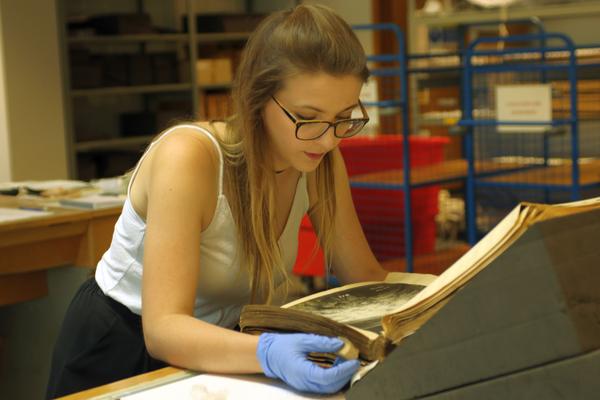
Cleaning an album of dockyard photographs at The National Archives
Projects: degrading film, and a volunteer survey at The National Archives
I was tasked with conserving a group of around 40 tagged paper files containing degrading cellulose nitrate X-rays which allowed me to carry out in depth research into the degradation mechanisms of nitrate film materials, to separate film stuck to paper documents and make repairs to very brittle paper files.
I also tried out a more challenging conservation treatment on cellulose acetate films; using different solvent combinations to separate the degraded film base from the image layer. This was both tricky and fun, and I’d like to investigate the process more before using it on collection materials.
I jointly led a volunteer survey of the film collection; the aim was to investigate the quantities, location and most importantly the condition of the collection. Jacqueline and I decided to carry out a pilot survey to make sure we were asking the right questions and the volunteers were clear about the observations they needed to make. I then built the full survey in The National Archives’ online conservation database, trained and managed volunteers and liaised with departments across the organisation. Over 6000 individual pieces of film were surveyed which has helped to inform a strategy of how the collection will be cared for moving forward, as an example the survey data is now being used on a new volunteer project to rehouse the film collection, and it is extremely rewarding to know that I was part of a project which has helped to better understand and care for the collection. This project taught me how to collaborate and communicate with teams outside of my own specialism, how to disseminate knowledge to non-conservation professionals and also the importance of IT skills when working on large scale projects.
Moving to Tate: colour photographs and experience of Tate’s busy exhibition programme
I was lucky enough to be able to follow my supervisor to the Paper and Photograph Conservation department at Tate for the second half of my internship. This was an unexpected change, but one that offered me a fantastic opportunity to gain a broader experience.
I worked closely with Tate’s photograph conservator, Laurence Martin, to complete a number of treatments and projects on both black and white and colour pictures. I assessed and treated around 13 mixed black and white prints from a large bequest from collector Barbara Lloyd; worked on a number of dye-destruction and chromogenic photographic prints by Christopher Steele-Perkins to expand my knowledge in the complex field of colour photography; and conserved a collection of over 100 Carbon prints by Henry Dixon.
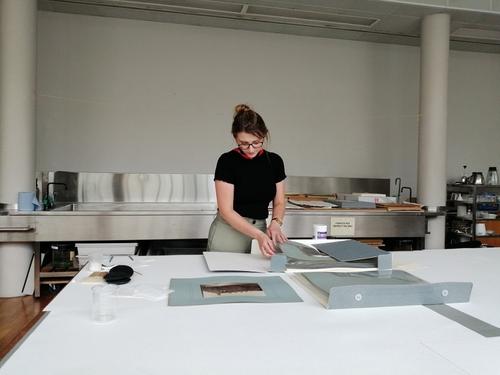
Working on a collection of carbon prints by Henry Dixon
This offered me the opportunity to hone my practical skills and also experience the different approaches taken in caring for photographs in a museum or gallery context, versus in an archival collection, for example, it is estimated that The National Archives holds over 8 million photographs and so it is practical to take a preventive and minimal approach to conservation in most cases. Tate however has a focus on exhibiting work, and the complex conservation issues which can arise from the use of experimental artistic techniques means that more time and resources may be required to process individual works.
While at Tate I worked with the acquisitions team to create condition reports and risk assessments for both photographs and works on paper prior to their acquisition into the collection which allowed me to think critically about the storage, display and conservation issues relating to a variety of materials and processes. I also carried out some treatments to newly acquired paper artworks in preparation for exhibition; one, a large scale collagraph print, approximately 3 meters by 1 meter, was particularly interesting as I had not worked on a collagraph before or an object of that size. I also got to spend a few days assisting the exhibitions team on the installation of the Blake exhibition at Tate Britain as well as the deinstallation of the Gonchorova exhibition at Tate Modern, where I worked with couriers from external museums and other exhibition staff to condition check around 60 photographs and paper works prior to and after exhibition. The process is fast paced and requires collaboration across curators, conservators, art handlers and couriers and it was exciting to see the work that goes into preparing the busy schedule of exhibitions and how a conservator’s role fits into this.
Getting to work in the conservation department of two large organisations was a wonderful opportunity for me to experience how different cultural institutions operate and get a sense of what my career might look like in the future.
Engaging audiences
I was encouraged to share my work with a variety of different audiences both at The National Archives and Tate. The most significant for me was the opportunity to present a paper written by Jacqueline and I, at the Icon19 Triennial Conference in Belfast about the film project at The National Archives. I presented to an audience of approximately 60 people in the main auditorium which was both a daunting and exciting prospect. As my first presentation to a large audience of my peers it was a huge personal achievement and a great opportunity to share the work Jacqueline and I had been doing. I also regularly gave short presentations about my work to groups of visitors who were touring the conservation studios; I held a practical session teaching groups of Year 5 students on how to repair photographs as part of a Kids in Museums day at The National Archives; as well as publishing a blog about some experimental work I had been carrying out on film materials.
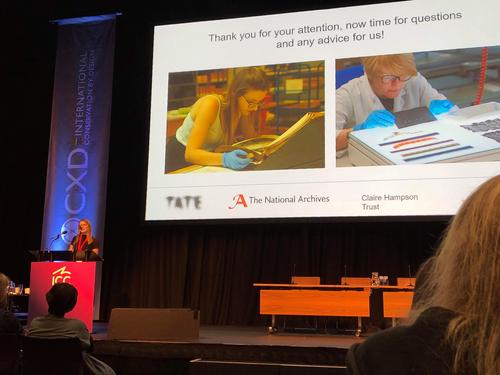
Presenting the joint paper at Icon19, Belfast
Additional opportunities
As part of my internship I also got to spend three days with photograph conservator Susie Clark ACR learning about the conservation of glass plate negatives. Susie is a specialist in this field, and it was inspiring to be able to have one-on-one teaching time in her studio. Susie also organised a day at The York Glaziers Trust so that I could get an insight into the principles of glass conservation; I had little previous knowledge so it was fascinating to see the studio and their huge ongoing project on York Minster’s stained-glass windows.
In between my transition from The National Archives to Tate, I also got to spend some time at the British Film Institute in their Conservation and Special Collections departments. Having worked with film materials at The National Archives, it was insightful to see how feature films are cared for and conserved on such a large scale. The Special Collections Department have an intriguing mixed collection of materials relating to feature films such as scripts, film stills and posters and I was fortunate enough to be able to work on some of these during my time there.
As an Icon intern, I was also encouraged to keep in touch with my fellow interns from across the UK. I organised a reciprocal visit with Arielle Juler who is at the National Trust for Scotland and I got to catch up with my other fellow interns at the Icon 2019 Triennial Conference. I recently went to the IIC’s Student and Emerging Conservators conference in Cologne so that I could meet early stage conservators and get an international view of the conservation field. It was inspiring to be around so many passionate people who are eager to begin their careers and make a positive impact to heritage collections internationally.
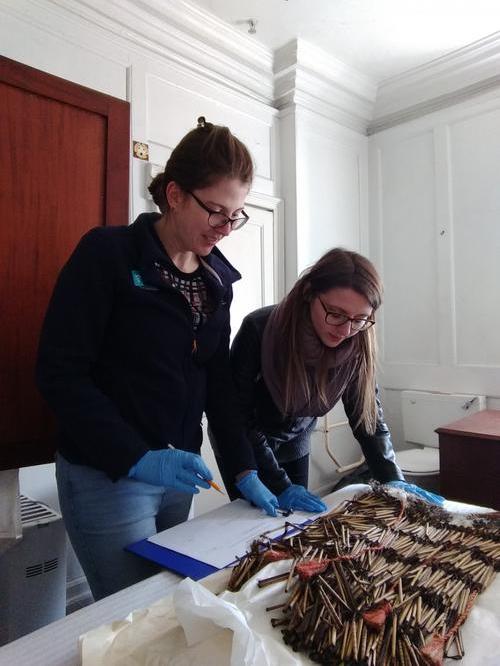
Condition checking a Mauri skirt at Newhailes House with Arielle Juler
Final words
I have had a fantastic year and I believe the internship has given me the skills and experience needed to transition from a graduate of conservation to my first employed role. I would like to thank Icon, my Icon Intern Advisor Lorna Calcutt ACR, The Clare Hampson Fund, both The National Archives and Tate, Susie Clark ACR, The York Glaziers Trust, Kieron Webb and Claire Smith from The British Film Institute and of course my supervisor Jacqueline Moon ACR for making it possible!

